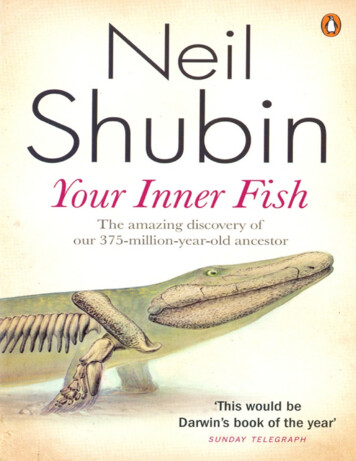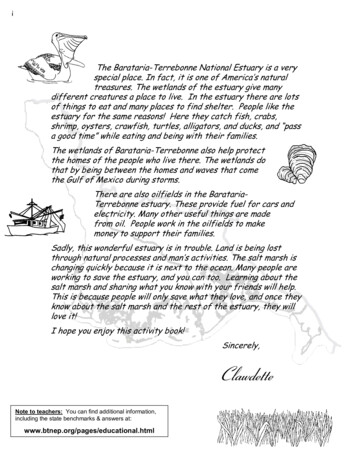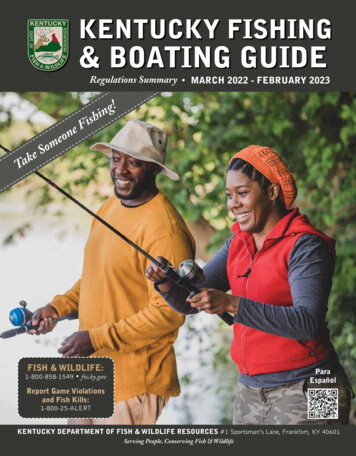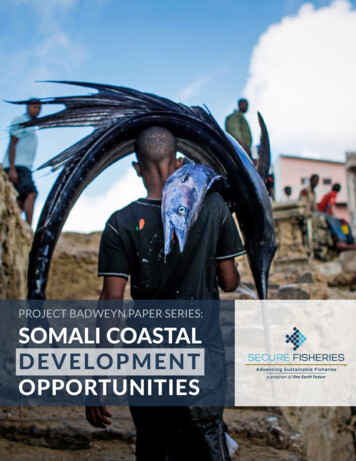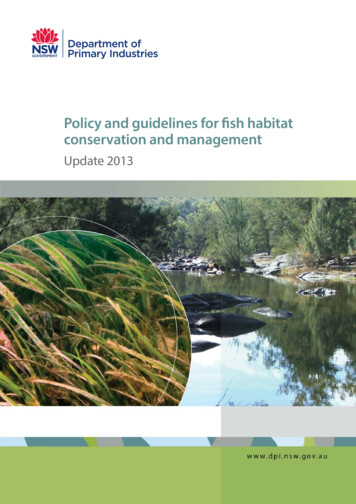
Transcription
Policy and guidelines for fish habitatconservation and managementUpdate 2013
Title: Fisheries NSW Policy and Guidelines for Fish Habitat Conservation and Management (2013 upate)Cover photos: Photo 1 – The Namoi River, Milly Hobson, NSW NSW DPI. Photo 2 – Halophila, Posidonia and ZosteraSeagrasses in NSW, Justin Gilligan, NSW NSW DPI.Author: Sarah Fairfull, Manager (Fisheries Ecosystems), Fisheries NSW, Wollongbar.For updates to this publication, check www.dpi.nsw.gov.au/publicationsPublished by the NSW Department of Primary Industries, a part of the Department of Trade and Investment, RegionalInfrastructure and Services.First published in 1998, updated in 1999 and latest major update and revision is June 2013.Policy Number: TI-O-138ISBN 978 1 74256 283 4AcknowledgementsThis document builds on the 1993 publications entitled “Estuarine Habitat Management Guidelines” and “FreshwaterHabitat Management Guidelines” which were edited and compiled by Jenny Burchmore, David Pollard, MargaretMiddelton and Rob Willliams. Des Dunstan contributed significantly to the first edition in 1985. It also provides anupdate on the 1999 version of this document, which was edited by Adam Smith and David Pollard.It has benefited from the input of a number of experts from within the Department including Sarah McGirr, Allan Lugg,Scott Carter, Marcus Riches, Peter Gallagher, John Pursey, Cameron Lay, Matthew Gordos, Simon Walsh, TimGippel, Rob Williams, Dean Gilligan, Patrick Dwyer, Trevor Daly, Gabrielle Holder, Glenn Tritton, Martin Angle, DavidColeman, Craig Roberts, Steve Barry, Rebekah Gomez-Fort, Darryl Sullings, Liz Rogers, Bradley Harrison, AdrianToovey, Cathie Warburton and Andy Stirling. State of New South Wales through Department of Trade and Investment, Regional Infrastructure and Services 2013.This publication is copyright. You may download, display, print and reproduce this material in an unaltered form only (retaining this notice) for yourpersonal use or for non-commercial use within your organisation. To copy, adapt, publish, distribute or commercialise any of this publication you willneed to seek permission from the Department of Trade and Investment, Regional Infrastructure and Services.DisclaimerThe information contained in this publication is based on knowledge and understanding at the time of writing (June 2013). However, because ofadvances in knowledge, users are reminded of the need to ensure that information on which they rely is up to date and to check the currency of theinformation with the appropriate officer of the NSW Department of Primary Industries or the user’s independent advisor.This document also provides a general summary of some of the provisions of the Fisheries Management Act 1994 and the Fisheries Management(General) Regulation 2010 as interpreted by the Department of Trade and Investment, Regional Infrastructure and Services at the time of writing (April2013). Compliance with the Act and its subordinate instruments is a legal requirement. This document does not provide or purport to provide legaladvice. Users are reminded of the need to ensure that the information upon which they rely is up-to-date by checking the currency of the informationwith the Department.TRIM reference: INT12/82898 Jobtrack 12093
Policy and guidelines for fish habitat conservation and management (2013 update)ForewordFish habitats underpin the productivity of our State’s fisheries resources. It is therefore vital that government and thecommunity work together to protect and restore them, in order to sustain our fisheries in the long-term. Theimportance of fish habitat is recognised in the NSW Government’s 10 year plan NSW 2021 which aims to protect ournatural environment, including its rivers, wetlands and coastal environments.This document outlines policies and guidelines aimed at maintaining and enhancing fish habitat for the benefit ofnative fish species, including threatened species, in marine, estuarine and freshwater environments. It builds onearlier versions which have been in place since the early 1990s.The document aims to help developers, their consultants and government and non-government organisations toensure compliance with legislation, policies and guidelines as they relate to fish habitat conservation andmanagement. It can be used to inform land use and natural resource management planning, development planningand assessment processes. It is also a valuable tool to improve awareness and understanding of the importance offish habitats and how impacts can be mitigated, managed or offset.Key changes to this version include the adoption of a new definition of ‘key fish habitats’ to which these policies andguidelines apply. The previous versions applied to all waterways in NSW, regardless of their value as fish habitat. Thisnew policy and guidelines reduces red tape for individuals and farmers wanting to undertake works in gullies ormodified waterways, such as canal estates and agricultural and irrigation areas, by removing the need to adhere tothese policies and guidelines as these waterways are not captured by this new definition.The document also provides up-to-date legislative and policy information for planning and development assessmentprocesses, including threatened species assessment and development affecting marine protected areas.The policies and guidelines are now better tailored to different development activities affecting key fish habitats, suchas the construction and maintenance of in-stream structures and barriers, various types of foreshore works andwaterfront development, urban streams and stormwater management, sediment extraction in waterways and use ofexplosives, electrical devices and other dangerous substances in waterways. For the first time it also incorporatesmore specific policies and guidelines for the protection of freshwater fish habitats.This version also incorporates the requirements of the former Fisheries NSW Policy and Guidelines for Fish FriendlyWaterway Crossings (2003) and the gazetted Fish Habitat Protection Plans No. 1 (General) and 2 (Seagrasses),which are in the process of being revoked. This again reduces red tape and makes it easier for the community tocomply with fish habitat protection requirements in one useful document.This vital resource will feed into a range of NSW Government reform programs including strategic and regionalplanning processes, the assessment of State Significant Development and Infrastructure projects and otherenvironmental regulation reforms, to ensure the sustainable management, and “no net loss”, of key fish habitats inNSW.I look forward to the continued cooperation of all interested parties in the implementation of this policy.Dr Geoff AllanExecutive Director, Fisheries NSWiiiNSW Department of Primary Industries, June 2013
ContentsForewordiii1. Introduction11.1 Who are these policies and guidelines for?21.2 What is the role of these policies and guidelines?21.3 What has changed since the 1999 version?21.4 User guide31.4.1 Quick "where to" guide41.5 Native fish of NSW41.6 Fish habitat conservation and management51.6.1 How will climate change affect fish habitats?1.7 Marine protected areas671.7.1 Proposed development within or in the locality of marine parks or aquatic reserves71.7.2 Intertidal protected areas71.8 Artificial reefs82. Overview of legislation102.1 Legislation102.2 Development approvals102.2.1 Development activities requiring a NSW DPI permit102.2.2 Integrated development process112.2.3 Approval and consultation requirements relating to Part 5 of the EP&A Act112.2.4 Infrastructure State Environmental Planning Policy (2007)122.3 Other approvals and permits122.3.1 Other NSW DPI permits122.3.2 Approvals from other agencies122.4 General permit conditions132.5 Planning instruments132.6 Protected and threatened species13iv2.6.1 Protected fish132.6.2 Overview of threatened species legislation132.6.3 The listing process142.6.4 Recovery planning142.6.5 Declaration of ‘critical habitat’152.6.6 Threat abatement planning152.6.7 Priorities Action Statement152.6.8 Licensing harm to threatened species152.6.9 Environmental impact assessment16NSW Department of Primary Industries, June 2013
Policy and guidelines for fish habitat conservation and management (2013 update)3. General policy – fish habitat conservation and management173.1 Introduction – general policy173.2 Key fish habitat management policies173.2.1 Habitat sensitivity173.2.2 Waterway classification193.2.3 Marine vegetation193.2.3.1 Legislation193.2.3.2 Policy and guidelines for harming marine vegetation203.2.3.3 Policy and guidelines for the gathering or collection of marine vegetation213.2.4 Riparian and freshwater aquatic vegetation223.2.4.1 Legislation223.2.4.2 Policy and guidelines for riparian and freshwater aquatic vegetation233.2.5 Snag management243.2.5.1 Legislation253.2.5.2 Policy and guidelines for snag management253.3 General requirements for developments263.3.1 Information requirements263.3.2 Standard precautions and mitigation measures283.3.3 Rehabilitation and compensation measures293.3.3.1 Legislation293.3.3.2 Policy and guidelines for habitat rehabilitation & environmental compensation 293.3.4 Environmental bonds303.3.4.1 Legislation313.3.4.2 Policy and guidelines for environmental bonds313.3.5 Monitoring requirements314. In-stream structures & barriers to fish passage334.1 Obstructions to fish passage334.1.1 Legislation334.1.2 Policy and guidelines for fish passage344.1.3 Information required for assessment354.2 Waterway crossings364.2.1 Legislation364.2.2 Policy and guidelines for waterway crossings374.3 Dams, weirs and regulators4.3.1 Policy and principles for managing dams and weirs384.3.2 Guidelines for fishways394.4 Floodgates4.4.1 Legislationv38NSW Department of Primary Industries, June 20134040
4.4.2 Policy and guidelines for floodgates4.5 Temporary in-stream structures41414.5.1 Legislation414.5.2 Guidelines for temporary structures414.6 In-stream rehabilitation works424.6.1 Legislation424.6.2 Policy and guidelines for in-stream rehabilitation works424.7 In-stream structure removal424.7.1 Legislation434.7.2 Policy and guidelines for in-stream structure removal434.8 Fish passage trade-offs4.8.1 Policy and guidelines for fish passage trade-offs43435. Foreshore works & waterfront development455.1 Foreshore structures455.1.1 Legislation455.1.2 General policies for foreshore structures465.1.3 Surrounding environmental considerations465.1.4 Policy and guidelines for surrounding environmental considerations475.1.5 Foreshore structure design considerations485.1.6 Policy and guidelines for jetties and wharves485.1.7 Policy and guidelines for boat ramps, boat sheds, pontoons and sliprails495.1.8 Policies and guidelines for moorings495.1.9 Policies and guidelines for swimming pools and enclosures505.2 Foreshore reclamation505.2.1 Legislation505.2.2 General policies for foreshore reclamation515.2.3 Beach nourishment515.2.3.1 Policies and guidelines for beach nourishment5.2.4 Foreshore stabilisation works and seawalls5.2.4.1 Policies and guidelines for foreshore stabilisation works5151526. General waterway management536.1 Urban streams and stormwater536.1.1 Maintaining fish passage in urban streams6.1.1.1 Legislation536.1.1.2 Policy for maintaining fish passage in urban streams536.1.2 Water management in urban areas6.1.2.1 Policy and guidelines for water management in urban areas6.1.3 Minimising habitat alterationvi53NSW Department of Primary Industries, June 2013545454
Policy and guidelines for fish habitat conservation and management (2013 update)6.1.3.1 Policy and guidelines for minimising habitat alteration in urban streams6.1.4 Protecting urban riparian vegetation6.1.4.1 Policy and guidelines for protecting urban riparian vegetation6.2 Water extraction and use555555566.2.1 Legislation and government initiatives566.2.2 Policy for water extraction and use576.3 Sediment extraction in waterways576.3.1 Extraction activities and potential impacts576.3.2 Legislation596.3.3 Policy and guidelines for sediment extraction (excluding fossicking)596.4 Intermittently closed and open lakes and lagoons (ICOLL) management606.4.1 Legislation616.4.2 Policy and guidelines for managing ICOLLs616.5 Water pollution626.5.1 Legislation and other government policies and initiatives636.5.2 Policy and guidelines for minimising water pollution646.6 Fish kills656.7 Use of explosives, electrical devices and other dangerous substances in waterways666.7.1 Legislation and standards666.7.2 Policy and guidelines for use of explosives, electrical devices and other dangeroussubstances in waterways66Appendix 1 Glossary and acronyms68Appendix 2 Other essential tools and guidelines71Appendix 3 Key fish habitats72Appendix 4 References78Appendix 5 NSW DPI contacts80viiNSW Department of Primary Industries, June 2013
Policy and guidelines for fish habitat conservation and management (2013 update)1. IntroductionIn April 2011, the NSW Department of Trade and Investment, Regional Infrastructure and Services (known as NSWTrade & Investment) was formed. NSW Trade & Investment drives sustainable economic growth in NSW and strives fora strong customer service culture in all areas of service delivery. There are three operational divisions: NSW Department of Primary Industries Industry, Innovation and Investment Division Resource and Energy DivisionThe NSW Department of Primary Industries’ (NSW DPI) purpose is to increase the capacity of primary industries andcommunities to drive economic growth across NSW. A key result area of NSW DPI’s performance is the sustainablemanagement of natural resources, including the conservation and management of ‘fish’ and their habitats in accordancewith the objects of the Fisheries Management Act 1994. Where the Act refers to the Director General it is a reference tothe Director General of NSW Trade & Investment and where it refers to the Department it is a reference to NSW Trade &Investment. In practice these functions are undertaken by the Director General of NSW DPI and its staff pursuant todelegated authority. NSW DPI is also responsible for: managing marine parks (as a member of the Marine Parks Authority) and aquatic reserves, rehabilitating fish habitats, sustainably managing commercial fishing and aquaculture industries, fostering indigenous community involvement in fishing and aquaculture, providing recreational fishers with quality fishing opportunities, and ensuring there is sustainable and equitable access to fishery resources.‘Fish’ - under the Fisheries Management Act 1994 means marine, estuarine or freshwater fish or other aquatic animallife at any stage of their life history (whether alive or dead). However, it excludes whales, mammals, reptiles, birds andamphibians which are managed under other legislation. Therefore in accordance with the Fisheries Management Actthe definition of “fish” for the purposes of these policies and guidelines includes not only fin fish (including sharks), butalso crustaceans, molluscs, worms, insects and other invertebrates that spend all or part of their life cycle in aquatichabitats.Fish habitat conservation and management underpins the sustainable management of NSW’s fisheries. Theirmanagement also contributes to the NSW Government’s 10 year plan NSW 2021 (see 2021.nsw.gov.au/) which aims toprotect our natural environment, including its rivers, wetlands and coastal environments. The government is alsocommitted to deliver on 13 state-wide targets for natural resource management by 2015. A state-wide Monitoring,Evaluation and Reporting Strategy is used to gather evidence and measure progress against the state-wide targets. Theimplementation of the policies and guidelines in this document aims to assist in delivering on several of these targetsincluding 1:1The numbers against each target are their numbers as per the Natural Resources Commission’s state-wide targets fornatural resource management (see x). Some of the targets arenot applicable to the Policy and Guidelines.1NSW Department of Primary Industries, June 2013
Policy and guidelines for fish habitat conservation and management (2013 update)Biodiversity1.By 2015 there is an increase in native vegetation extent and an improvement in native vegetation condition2.By 2015 there is an increase in the number of sustainable populations of a range of native fauna species3.By 2015 there is an increase in the recovery of threatened species, populations and ecological communitiesWater5.By 2015 there is an improvement in the condition of riverine ecosystems7.By 2015 there is no decline in the condition of marine waters and ecosystems8.By 2015 there is an improvement in the condition of important wetlands and the extent of those wetlands ismaintained9.By 2015 there is an improvement in the condition of estuaries and coastal lake ecosystemsCommunity12. Natural resource decisions contribute to improving or maintaining economic sustainability and social well-beingThis document focuses on the sustainable management of marine, estuarine and freshwater habitats and riparianvegetation which is vital to healthy and productive fisheries. It also outlines policies and guidelines that have beendeveloped to maintain and enhance fish habitat and to address threatening processes for the benefit of native fishspecies, including threatened species, in marine, estuarine and freshwater environments.1.1 Who are these policies and guidelines for?This document focuses on promoting compliance with legislation relating to fish habitatconservation and management. It aims to assist local and state government authorities,proponents of developments and their advisers, and individuals or non-governmentorganisations concerned with the planning and management of our aquatic resources. It canbe used to inform land use and natural resource management planning, developmentplanning and assessment processes. It is also a valuable tool to improve awareness andunderstanding of the importance of fish habitats and how impacts can be mitigated ormanaged. Local government State governmentauthorities Developers Consultants Non-governmentorganisationsNot all aspects of aquatic habitat protection and management are covered in this document Individualsas a range of other state and local government authorities have control of, or interest inaquatic habitats through protected area management, water allocation and use, catchmentand land use management, extractive industries, pollution control, etc. These authorities should be consulted on theirrespective roles.1.2 What is the role of these policies and guidelines?NSW DPI will take these policies and guidelines into account when assessing and either approving or refusing proposalsfor developments or other activities affecting fish habitats. These policies and guidelines will assist NSW DPI to applythe legislative requirements consistently and fairly to individual proposals. NSW DPI recommends proponents ofdevelopments or other activities to submit proposals that address these policies and guidelines.1.3 What has changed since the 1999 version?Key changes to this updated version include: Provision of up-to-date information on the Fisheries Management Act 1994 and Fisheries Management (General)Regulation 2010 and how they apply to planning and development assessment processes, including threatenedspecies assessment and development affecting marine protected areas. An improved definition of the ‘key fish habitats’ to which these policies and guidelines apply. The incorporation of a new classification scheme for the conservation and management of sensitive fish habitattypes and waterway classes which may be affected by land use planning and development activities. Revised policies and guidelines that are better tailored to guide different development activities to assist thoseinvolved in the strategic planning and assessment of future land uses and development. New and revised sectionsare provided on issues such as fish passage around in-stream structures and barriers, foreshore works andwaterfront development, urban streams and stormwater, sediment extraction in waterways and use of explosives,electrical devices and other dangerous substances in waterways. Updated references to other relevant natural resource management agencies and legislation related to aquatichabitat management and fisheries conservation. More specific information and environmental assessment requirements for the assessment of developmentsaffecting key fish habitats.2NSW Department of Primary Industries, June 2013
Policy and guidelines for fish habitat conservation and management (2013 update) The removal of references to commercial and recreational fisheries and aquaculture management policies andguidelines as these are more appropriately dealt with via other existing publications (available fromwww.dpi.nsw.gov.au/fisheries). Incorporation of the Policy and Guidelines for Fish Friendly Waterway Crossings (2003). Integration of the requirements of Fish Habitat Protection Plans No. 1 (General) and 2 (Seagrasses), which are inthe process of being revoked. More specific policies and guidelines for the protection of freshwater fish habitat. Removal of specific reference to listed threatened and protected species of fish and protected areas of aquatichabitat. Up-to-date information on these issues can be sourced from www.dpi.nsw.gov.au/fisheries/speciesprotection.1.4 User guideThis document is available in both hard copy and electronic format. Hard copies can be obtained from your local NSWDPI Fisheries Office (see Appendix 5).The document can be viewed and downloaded (PDF) at www.dpi.nsw.gov.au/fisheries.Key acronyms used are: NSW DPI – NSW Department of Primary Industries FM Act – Fisheries Management Act 1994 (NSW) FM Regulation – Fisheries Management (General) Regulation (2010) (NSW) EP&A Act – Environmental Planning and Assessment Act 1979 (NSW) OEH – NSW Office of Environment and Heritage Trade & Investment – NSW Department of Trade and Investment, Regional Infrastructure and ServicesA glossary of key terms and acronyms, a list of useful tools, guidelines and supporting information, references and keyNSW DPI contacts are provided in the appendices.These policies and guidelines have been developed from sound research and in consultation with stakeholders.Appendices 2 and 4 provide references and sources of information used.There are six chapters. Different chapters will assist with different aspects of planning or management as outlined below.Chapter 1Chapter 2Chapter 3Chapter 4Chapter 5Chapter 63Background information on the document, its useand an introduction to the aquatic habitats andfisheries resources of NSWThe legislative requirements relevant to planningand development which may affect fisheries oraquatic habitats in NSWThe general policies and classification schemes forthe protection and management of fish habitats andoutlines NSW DPI’s generic informationrequirements for development proposals affectingfish habitats in NSWSpecific policies and guidelines for maintaining andenhancing the free passage of fish around in-streamstructures and barriersSpecific policies and guidelines for foreshore worksand waterfront developmentsSpecific policies and guidelines for the managementof other activities affecting waterwaysNSW Department of Primary Industries, June 2013Useful context and if you know little about fishand fish habitats you should start here.Chapters 2 and 3 outline the things NSW DPIwill use to assess a development proposal. It isrecommended that you start with these twochapters to understand the legislation andgeneral policies.Chapter 3 will assist you to classify the type offish habitat you may be affecting. You shouldthen apply the relevant policies and guidelinesto that habitat type.Chapter 3 also outlines the environmentalassessment information you should gatherbefore submitting a proposal to NSW DPI forreview.These are specific to particular activitiesaffecting fish habitats and fisheries resources.If you are planning to undertake any of theseactivities you should review the relevantchapter.
Policy and guidelines for fish habitat conservation and management (2013 update)1.4.1 Quick “where to” guideThe list below aims to assist with locating relevant information for common types of development or activities which youmay be planning on undertaking. It does not cover all of the activities outlined in the document. If you are unsure, contactyour local Fisheries NSW office for assistance (see Appendix 5).Development/ActivityFor ALL developments and activities within or on thebanks of a waterway, wetland or estuary in NSWBuilding a jetty, pontoon or placing mooringPlacing a boat ramp or boat shedRepairing or replacing a floodgateBuilding a waterway crossingBuilding or repairing a dam, weir or regulatorPlanning a new subdivisionDredging and mining activitiesStabilising a riverbank or coastal foreshoreOpening up a coastal lagoonReporting a fish killUsing explosives in waterwaysRelevant section(s)See Chapters 2 and 3 before you start to find out aboutthe relevant legislation, general policies and guidelines,environmental assessment requirements and to determinewhat type of habitat you are impacting via the fish habitatclassification schemes.See also section 5.1See also section 5.1See also sections 4.1 and 4.4See also sections 4.1 and 4.2See also sections 4.1 and 4.3See also section 6.1See also section 6.3See also section 5.2See also section 6.4See section 6.6See also section 6.71.5 Native fish of NSWThere are over 1000 species of fin-fish in NSW and tens of thousands ofspecies of crustaceans, aquatic molluscs, beachworms, aquatic insectsand other aquatic invertebrates – all of which are classified as ‘fish’ underthe FM Act (as per the definition of ‘fish’ in section 1). More species of finfish are found in marine environments than in freshwater environments.The recent Census of Marine Life recorded almost 33,000 marine speciesin Australian waters and estimated that up to 250,000 marine species maybe present.Several marine fish species, including the Greynurse Shark, White SharkPurple Spotted Gudgeon (G Schmida)and Black Rockcod have declined in abundance and are now listed as‘threatened’ in NSW (see section 2.6.2). In addition, many marine andestuarine species have been listed as ‘protected’ (see section 2.6.1) including the Ballina Angelfish, Eastern Blue Devil,Elegant Wrasse, Goldspotted Rockcod (Estuary Cod), Queensland Groper, Sandtiger Shark (Herbsts Nurse Shark) andall Syngnathids (i.e. sea dragons, pipefish, etc.).NSW has an estimated 80 species of freshwater fish including native, introduced, and estuarine species (NSW Fisheries2001). Of these, approximately 55 are native species that spend the majority of their lifecycle in freshwater. Due to thedegradation of river systems and the loss of aquatic habitat, aquatic biodiversity has been declining. A number of fishspecies, populations and ecological communities have been listed as ‘threatened’ (see section 2.6.2).The NSW Rivers Survey (Harris and Gehrke 1997) studied the distribution, diversity and abundance of native fishes inNSW rivers. The survey found only 39 native fish species. Previous surveys in 1983 had recorded an additional 9species which were not sampled during the NSW Rivers Survey. Also of concern was the finding that approximately 25%of fish found showed evidence of parasites and other diseases (Harris and Gehrke 1997).Morris et al. (2001) reviewed the status of more than 30 species of freshwater fish species found in south-easternAustralia. The report highlighted the conservation concerns for many of the freshwater species occurring in NSW. Themain causes of decline in freshwater fishes include: habitat degradation due to various forms of water pollution, catchment development and land use-related activities, changes to water flow regimes, barriers to fish passage, the introduction of alien fish species, and historical overfishing.The findings of the second Murray-Darling Basin ecosystem health check also illustrate the continuing concern with thestatus of native freshwater fish, including in the NSW valleys. Of the NSW valleys in the study only the Paroo was foundto have a fish community in good condition, with the Border Rivers fish community in moderate condition. The remainingvalleys reported poor to extremely poor fish community condition, with the Macquarie, Lachlan, Murrumbidgee and UpperMurray valleys reporting the worst (extremely poor) fish community condition. The study found that alien fish made upmore than half the numbers of fish in ten valleys – with more than 75 percent of fish numbers in the Murrumbidgee valley4NSW Department of Primary Industries, June 2013
Policy and guidelines for fish habitat conservation and management (2013 update)comprised of alien species, the bulk being Common Carp. The Border Rivers, Central Murray, Darling and Paroo valleysall had native species contributing more than 75 percent of their total fish numbers. A major part of the native fishbiomass came from Murray Cod and Golden Perch and the smaller and more numerous Bony Herring (MDBA 2012).1.6 Fish habitat conservation and management‘Habitat’ is defined under the FM Act as ‘any area occupied, or periodically or occasionally occupied, by fish or marinevegetation (or both), and includes any biotic or abiotic component’. This includes the water column, the substrate ( suchas sand, mud, cobbles or reef) and other features submerged by water which are used by fish to shelter, access food(such as aquatic vegetation and algae), to breed and which provide territorial markers for migration. A range ofgovernment and community programs and activities contribute to the conservation and management of fish habitat, forexample, catchment management, water pollution reduction
It is also a valuable tool to improve awareness and understanding of the importance of fish habitats and how impacts can be mitigated,managed or offset. Key changes to this version include the adoption of a new definition of 'key fish habitats' to which these policies and
